
Welcome to Hyperion Records, an independent British classical label devoted to presenting high-quality recordings of music of all styles and from all periods from the twelfth century to the twenty-first.
Hyperion offers both CDs, and downloads in a number of formats. The site is also available in several languages.
Please use the dropdown buttons to set your preferred options, or use the checkbox to accept the defaults.

| Philharmonia Orchestra, Christoph von Dohnányi (conductor)» More |
| Britten Sinfonia, Thomas Adès (conductor)» More |
| Orchestre Révolutionnaire et Romantique, Sir John Eliot Gardiner (conductor)» More |
| London Symphony Orchestra, Bernard Haitink (conductor)» More |
| National Symphony Orchestra, Gianandrea Noseda (conductor)» More |
One aspect of the symphony that struck Hoffmann forcibly was its inner unity. Even a listener coming to the work for the first time will immediately connect the ‘knocking’ rhythmic figure which runs through the scherzo with the four-note motif of the symphony’s opening bars. The first movement itself is a locus classicus of symphonic unity, with the omnipresent ‘fate’ rhythm acting as an accompaniment to the warmly lyrical second subject. The mood changes again in the recapitulation, where the oboe breaks in to the opening subject with a miniature cadenza of great expressive depth. The oboe’s melody is actually a variant of the bars that precede it, but the contrast is overwhelming.
Behind the slow movement lies the shadow of the double variation design so assiduously cultivated by Haydn, in which two themes—one in the major, the other in the minor—are varied alternately. Beethoven’s design is abridged, with the second theme consisting of little more than a short-lived blaze of C major—as though in anticipation of the ultimate triumph of that key embodied in the symphony’s finale; and following the third variation the C major idea disappears altogether, leaving the remainder of the canvas to be filled with an elaboration of the first theme.
Beethoven had originally intended to have two statements each of the scherzo and trio, followed by the pianissimo da capo, but a last-moment change of heart led him to delete the long repeat of scherzo and trio. He may have feared that the extended form would weaken the symphony’s most revolutionary idea—the interruption of the finale with a further reprise of the scherzo. The change of colour for the return of the scherzo following the trio, with braying horns replaced by delicate pizzicatos, and the atmosphere of hushed mystery maintained throughout, is an astonishingly original stroke. Towards the end, the inner strings sustain a long-held note while the timpani gently tap out a rhythmic figure, before a crescendo of tremendous force propels the music forwards into the finale.
The finale’s emergence out of the shadowy scherzo—and with it the first use in a symphony by a great composer of trombones and piccolo—is a shattering moment, and one whose effect can scarcely be blunted by familiarity. The progress from darkness to light is renewed at the end of the finale’s powerful development section, with the reprise of the scherzo. This time the ensuing C major triumph has perforce to be even more assertive, and it is largely this that necessitates a Presto coda ending with more than fifty fortissimo bars of pure C major—a glorious victory for the forces of light.
from notes by Misha Donat © 2007
L’unité interne de cette symphonie: voilà ce qui frappa tant Hoffmann. Tout auditeur découvrant l’œuvre rattachera d’emblée la figure rythmique «cliquetante» qui parcourt le scherzo au motif de quatre notes des mesures initiales. Le premier mouvement est en soi un momentclé de l’unité symphonique, avec l’omniprésent rythme «fatal» qui fait comme un accompagnement au second sujet chaleureusement lyrique. Le climat change de nouveau à la réexposition, où le hautbois se rode au sujet d’ouverture avec une cadenza miniature profondément expressive. La mélodie du hautbois se contente de varier les mesures qui la précèdent mais, là encore, le contraste est irrésistible.
Derrière le mouvement lent se cache l’ombre du schéma de double variation si assidûment cultivé par Haydn, avec deux thèmes (l’un en majeur, l’autre en mineur) variés en alternance. Chez Beethoven, ce schéma est abrégé, le second thème n’étant guère plus qu’un éphémère flamboiement d’ut majeur—comme pour anticiper le triomphe ultime de cette tonalité concrétisée dans le finale de la symphonie; cette idée en ut majeur disparaît totalement après la troisième variation, un développement du premier thème venant combler le reste du canevas.
Initialement, Beethoven projetait de faire précéder le pianissimo da capo de deux énonciations (une du scherzo et une du trio) mais, se ravisant au dernier moment, il supprima la longue répétition du scherzo et du trio. Peut-être a-t-il craint, par cette forme développée, d’affaiblir l’idée la plus révolutionnaire de cette symphonie: l’interruption du finale par une nouvelle reprise du scherzo. Le changement de couleur pour le retour du scherzo après le trio, avec les cors stridents remplacés par de délicats pizzicati, est étonnamment original, de même que le constant et profond mystère. Vers la fin, les cordes intérieures tiennent longtemps une note et les timbales tapotent une figure rythmique avant qu’un crescendo d’une force immense ne propulse la musique vers le finale.
Le finale qui émerge du scherzo ombragé—et, avec lui, l’utilisation de trombones et d’un piccolo, novatrice dans une symphonie de grand compositeur—est un moment bouleversant, que l’habitude ne saurait émousser. Le passage des ténèbres à la lumière est renouvelé à la fin de la puissante section de développement du finale, avec la reprise du scherzo. Cette fois, le triomphe en ut majeur qui s’ensuit doit, par force, être encore plus affirmé, et c’est en grande partie ce qui justifie la coda Presto s’achevant sur plus de cinquante mesures fortissimo en pur ut majeur—une victoire glorieuse pour les forces de la lumière.
extrait des notes rédigées par Misha Donat © 2007
Français: Hypérion
Hoffmann war besonders von einem Aspekt der Sinfonie beeindruckt, nämlich ihrer inneren Einheit. Selbst ein Hörer, der das Werk zum ersten Mal vernimmt, wird sofort die sich durch das Scherzo ziehende klopfende rhythmische Geste mit dem Viertonmotiv aus den einleitenden Sinfonietakten verbinden. Schon der erste Satz mit seinem allgegenwärtigen, unter anderem auch das warme lyrische zweite Thema begleitenden Schicksalsrhythmus ist ein Schulbeispiel für sinfonische Einheit. Die Stimmung ändert sich wieder in der Reprise, wenn die Oboe mit einer Minikadenz von starker Ausdruckstiefe das Anfangsthema unterbricht. Diese Oboenmelodie ist eigentlich eine Variante der vorangegangenen Takte, aber wieder überwältigt der Kontrast.
Hinter dem langsamen Satz liegt der Schatten der Doppelvariationsform, die Haydn so ausgiebig pflegte. Hier werden zwei Themen—eins in Dur und das andere in Moll—abwechselnd variiert. Beethoven kürzte die Doppelvariationsform, und das zweite Thema besteht aus nicht mehr als einem kurzlebigen Aufflackern von C-Dur (dabei wirkt dieses C-Dur wie eine Vorbereitung auf den im Schlusssatz schließlich erreichte Triumph dieser Tonart), und nach der dritten Variation verschwindet der C-Dur-Gedanke ganz und überlässt das Spielfeld der Ausarbeitung des ersten Themas.
Beethoven plante im Scherzo ursprünglich jeweils zwei Durchgänge des A-Teils und Trios, gefolgt von einer mit pianissimo da capo überschriebenen Wiederholung. Im letzten Moment änderte der Komponist aber seine Meinung und strich die lange Wiederholung des A- und B-Teils. Vielleicht fürchtete Beethoven, dass die erweitete Form die revolutionärste Idee der Sinfonie schwächen würde—nämlich die Unterbrechung des Schlusssatzes durch eine erneute Wiederholung des A-Teils aus dem Scherzo. Ein erstaunlich origineller Einfall ist die Farbänderung bei der Rückkehr des A-Teils nach dem Trio, wo delikate Pizzikati die schmetternden Hörner ersetzen und eine Atmosphäre verschleierter Mystik durchgängig beibehalten wird. Gegen Ende halten die mittleren Streicher eine lange Note aus, während die Pauken sanft eine rhythmische Geste schlagen, bis ein Crescendo von enormer Stärke die Musik in den Schlusssatz katapultiert.
Das Heraustreten des Schlusssatzes aus dem schattenhaften Scherzo—und damit der erste Einsatz von Posaunen und Piccoloflöten in einer Sinfonie eines großen Komponisten—ist ein erschütternder Moment, dessen Wirkung auch durch Vertrautheit kaum geschwächt wird. Der Schritt aus der Dunkelheit zum Licht wiederholt sich in diesem Satz noch einmal, am Ende des mächtigen Durchführungsabschnitts, bei der Wiederholung des A-Teils aus dem Scherzo. Dort muss der daraus resultierende C-Dur-Triumph notgedrungen selbstbewusster sein, und das ist einer der Hauptgründe, warum die mit Presto überschriebene Koda mit über mehr als 50 fortissimo-Takten in reinstem C-Dur endet—ein strahlender Sieg für die Mächte des Lichts.
aus dem Begleittext von Misha Donat © 2007
Deutsch: Elke Hockings
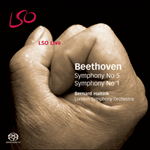 Beethoven: Symphonies Nos 1 & 5 Beethoven: Symphonies Nos 1 & 5Beethoven again raised the expressive force of the genre with his Symphony No 5 and introduced a theatrical element to it. Beginning with the most famous phrase in classical music and one of the most joyous, uplifting movements as a finale it is a ...» More |
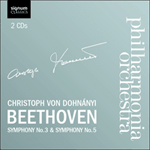 Beethoven: Symphonies Nos 3 & 5 Beethoven: Symphonies Nos 3 & 5Two crowning achievements of Beethoven’s aptly titled ‘Heroic’ compositional period: Symphonies No 3 (Eroica) and No 5, arguably the single most popular piece of classical music in the Western canon.» More |
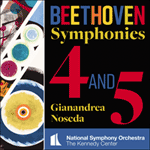 Beethoven: Symphonies Nos 4 & 5 Beethoven: Symphonies Nos 4 & 5Two symphonies from Beethoven's so-called 'Heroic' period—No 4 completed in 1806 and the supremely defiant No 5 begun in the same year and completed two years later.» More |
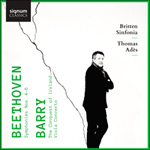 Beethoven: Symphonies Nos 4, 5 & 6 Beethoven: Symphonies Nos 4, 5 & 6Impeccable performances of Beethoven's middle three symphonies are here presented alongside Gerald Barry's enterprising viola concerto (with soloist Lawrence Power) and the extreme cantata 'The Conquest of Ireland' (bass Joshua Bloom and a text by ...» More |
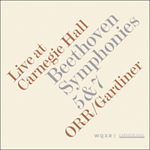 Beethoven: Symphonies Nos 5 & 7 Beethoven: Symphonies Nos 5 & 7Sir John Eliot’s Gardiner’s reading of these familiar pieces highlights their revolutionary origin. Performing on period instruments, the Orchestre Révolutionnaire et Romantique brings light, clarity and brisk energy, as well as a warm and genuine ...» More |

